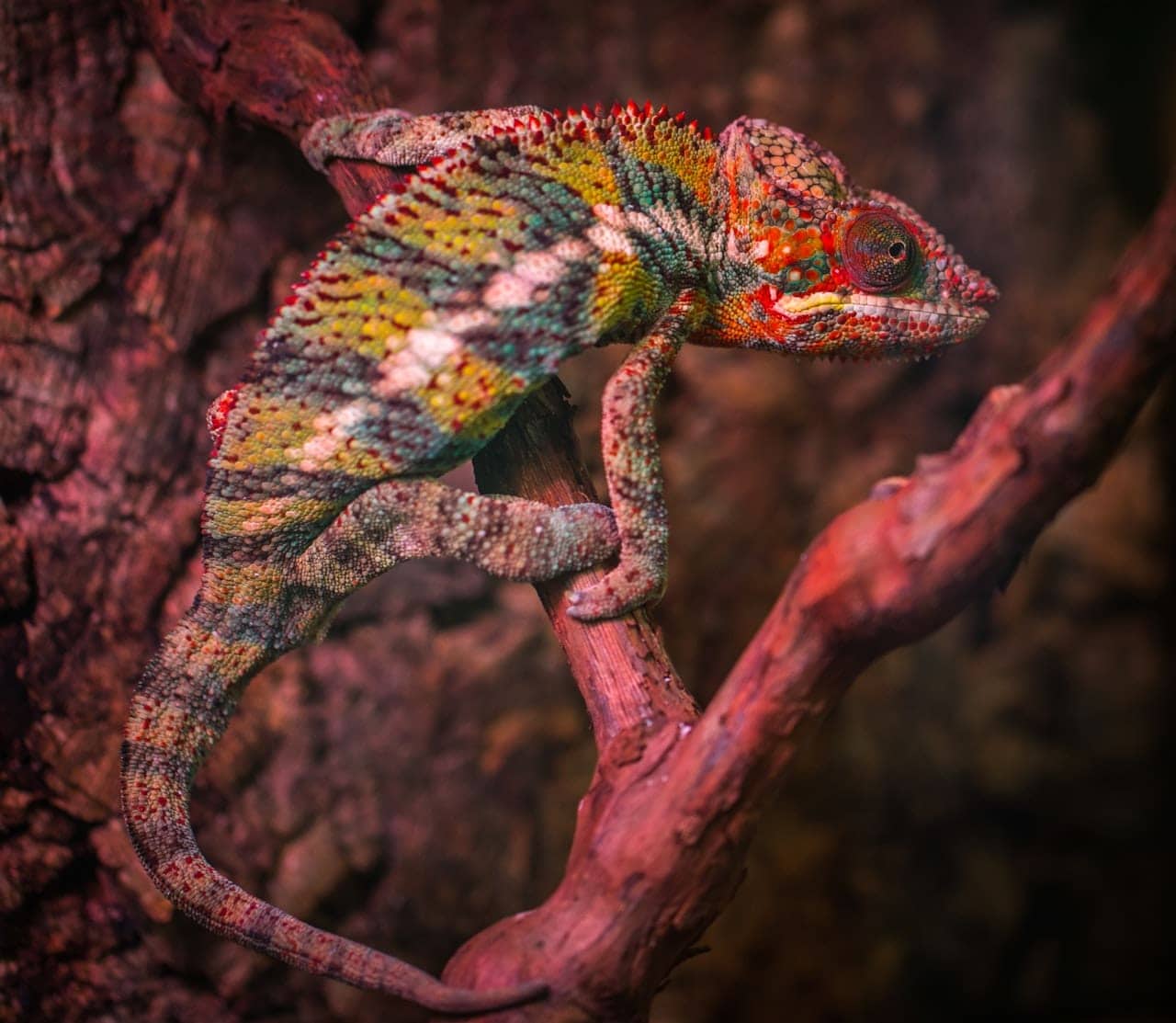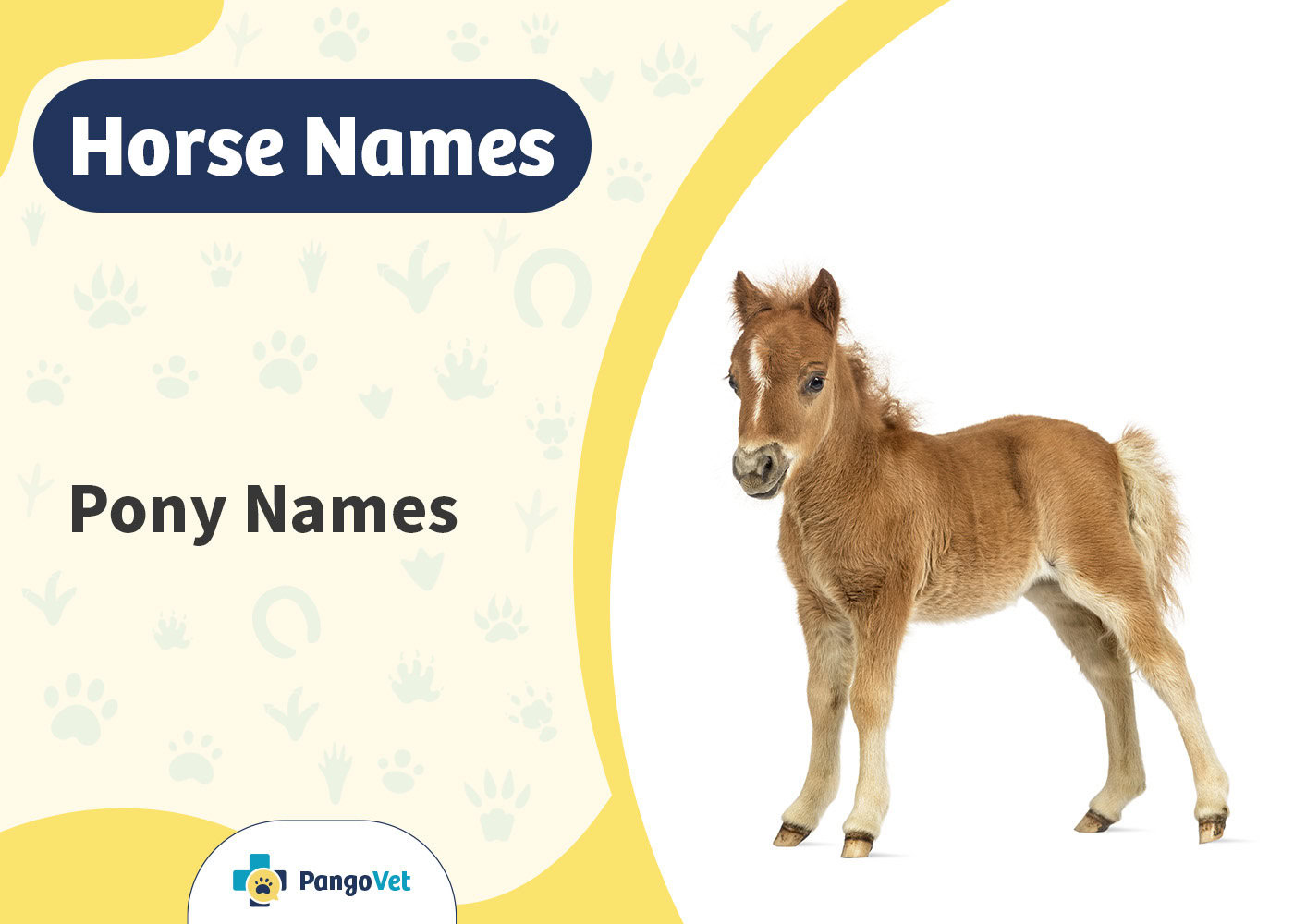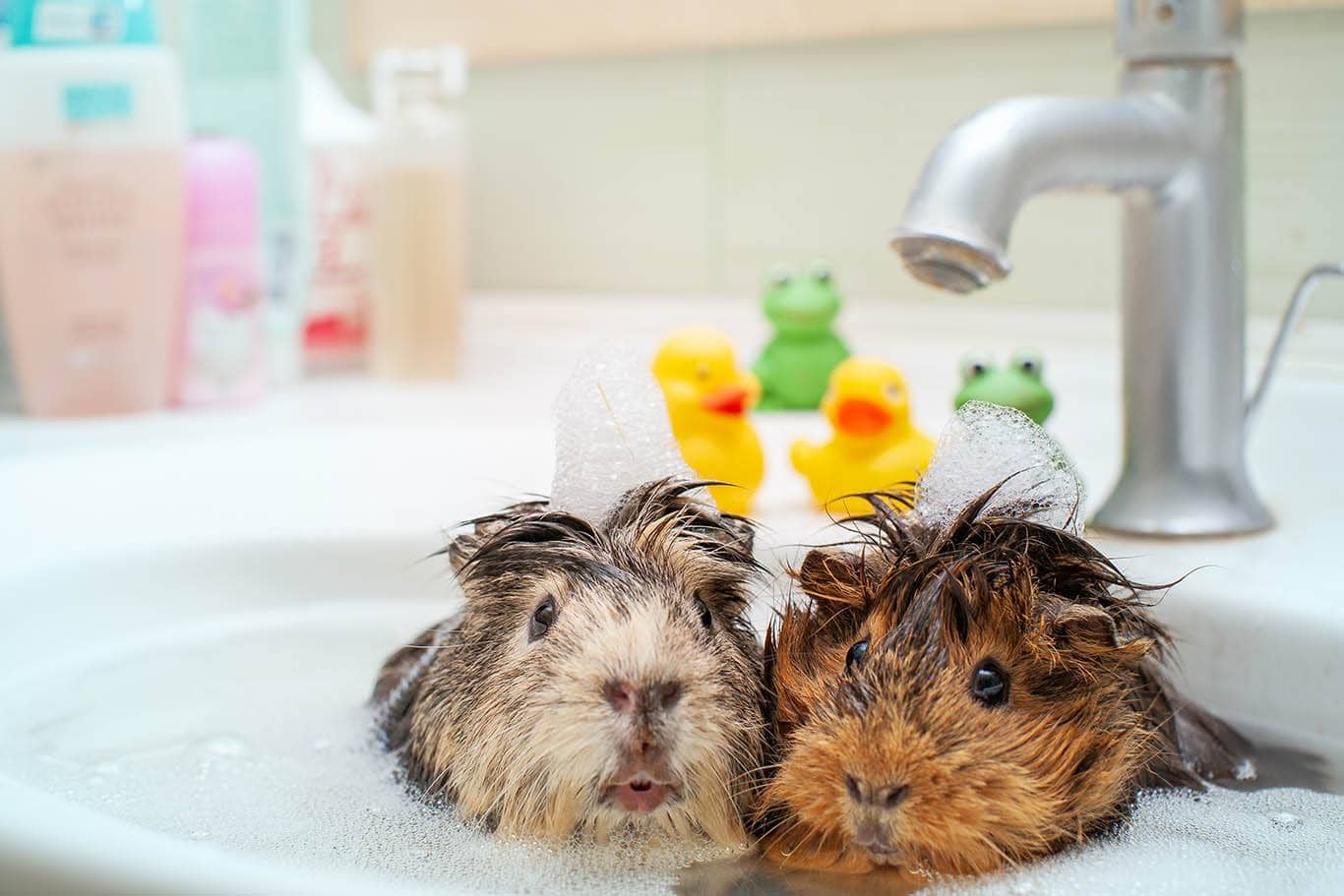Click to Skip Ahead
If you are in the market for a pet chameleon and plan on checking out your local PetSmart, it is a good idea to know what price you should expect to pay for this striking reptile.
Although there are many species of chameleons in the pet trade, this company only sells one in particular, the veiled chameleon. The veiled chameleon is currently priced at $79.99 per specimen at PetSmart, though this price tag may be different depending on your location.
If you are seriously considering making one of these beautiful creatures part of your household, there are vital things to know about their care requirements before making the commitment. Chameleons are beautiful animals and are stand-out pets, but they are not for everyone.
We put together information about the veiled chameleon to help you decide if this species is right for you and vice versa.

The Veiled Chameleon
The veiled chameleon (C. calyptratus) is also commonly referred to as the Yemen chameleon due to its origin in the Arabian Peninsula in Yemen and Saudi Arabia. These arboreal lizards were first imported into the United States in the 1980s.
Although little information was known about them, their unique appearance caused them to take the pet trade by storm. Most veiled chameleons in the pet trade nowadays are captive born and bred, as the number of wild-caught specimens being imported has declined significantly.
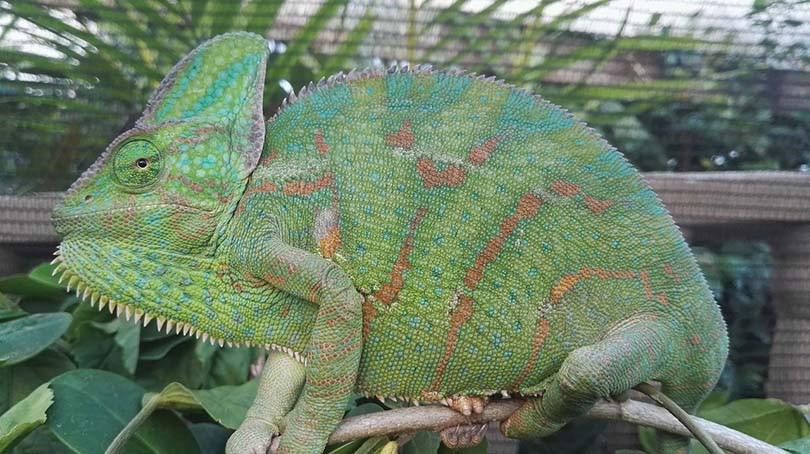
Veiled Chameleon Behavior
Veiled chameleons are interesting and beautiful creatures, but they are not friendly companions that want to be handled. They will do best with little to no handling at all and tend to be on the aggressive side, even when they are captive-bred and raised by humans.
This is not an animal that is going to want you to bring it out and pass it around to show it off to guests. It’s certainly something to be admired, but it’s best to do so from a distance while it’s in its enclosure, to avoid causing it undue stress.
It is important to keep this in mind before purchasing a chameleon from PetSmart or any reputable reptile breeder. You need to understand and respect this animal’s temperament and behavior and respect its needs for minimal handling.
Veiled Chameleon Appearance
It’s no secret that veiled chameleons are so popular because of their appearance. Not only do they have a unique look, but they also change colors and have impressive casques on their heads. Their famous, long, sticky tongues can be shot a distance that is 1.5 times the length of their bodies to catch unsuspecting prey.
They have curly, prehensile tails that serve them well on their home in the branches. Their eyes operate independently, so they can look in different directions simultaneously.
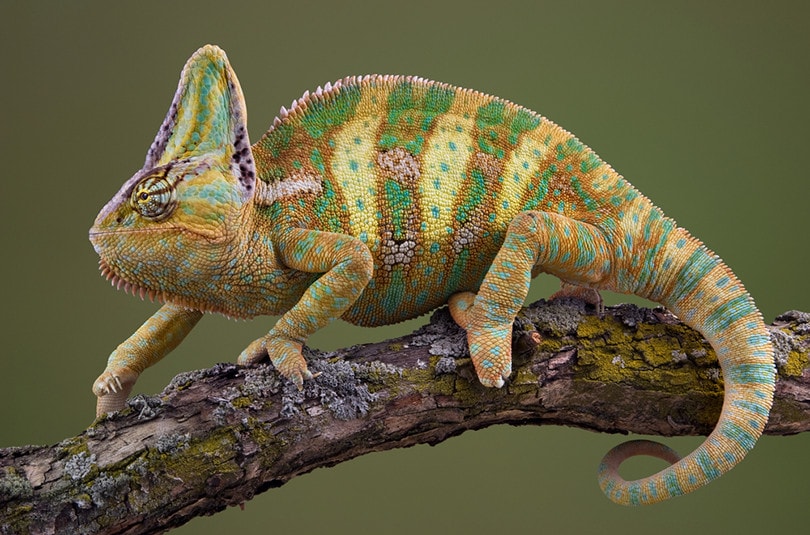
Male vs. Female Chameleons
Males and females have similar characteristics but also differ in many ways. While both sexes display varying coloration, males are typically larger and longer, with a higher casque on the head. They also have a tarsal spur on each of their hind heels, which is absent in females.
The male veiled chameleons typically come in bright gold, green, or blue with bands of yellow, orange, or black. Females are typically green and not as colorful as their male counterparts.
Veiled Chameleon Size
The adult size of a veiled chameleon depends on their sex. Males tend to grow to a length between 17 and 24 inches from their snouts to the ends of their tails, while females will typically reach somewhere between 10 and 14 inches.
Veiled chameleons are light-bodied reptiles, with males reaching 3 to 6 ounces and females reaching 3 to 4 ounces when fully grown.
Veiled Chameleon Lifespan
Veiled chameleons do not have long lifespans compared to a lot of other reptiles. If captive-bred and properly cared for, females will typically live up to 5 years and males up to 8 years. Wild-caught veiled chameleons are not as common in the pet trade nowadays, but they typically have a shorter lifespan in captivity due to the drastic environmental change, high stress levels, and potential for having unknown parasites and diseases.
Veiled Chameleon Care Level
While they are among the most common and widely kept species of chameleons, veiled chameleons are best suited for intermediate and advanced reptile keepers due to their temperaments and husbandry needs.
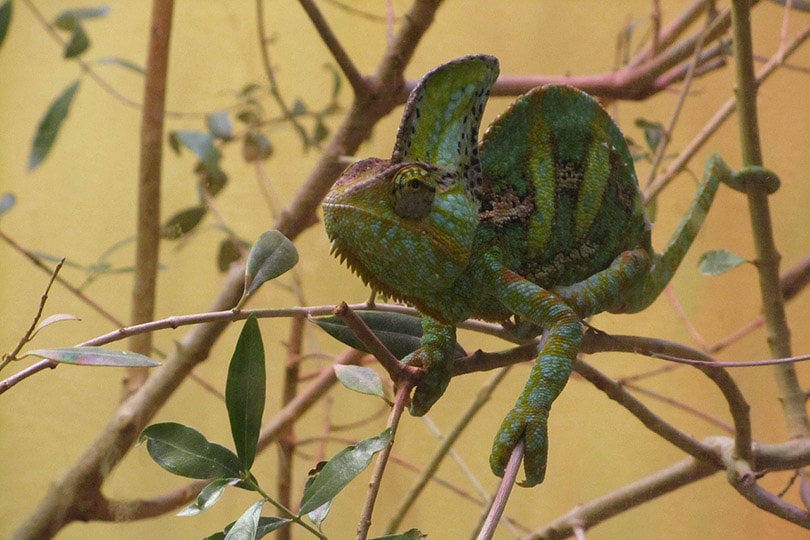
Veiled Chameleon Diet
It is ideal to do your best to replicate the wild diet for a pet chameleon. Consulting a licensed exotic animal veterinarian is highly recommended so you can create a proper meal plan to ensure that your chameleon is getting the nutrition it needs.
Most of a veiled chameleon’s diet should consist of insects like crickets, grasshoppers, mealworms, roaches, locusts, wax worms, and silkworms. It’s not strictly carnivorous and can benefit from having some plant material in its diet too. Options that can be provided are bits of broccoli, carrots, dandelion leaves, and pieces of the hibiscus plant. It is vital to ensure that any plant material is free of pesticides or any other harmful chemicals. Talk to your licensed exotic animal vet about your proposed meal plan and the quantity of food that you need to offer your veiled chameleon throughout its lifetime.
Chameleons will likely not drink water from a bowl, so it is recommended that their cages be misted regularly and a drip system provided to ensure that they can get their needed water intake and avoid dehydration.
Veiled Chameleon Supplementation
A veiled chameleon’s diet can be supplemented by dusting calcium on its food every other week or so to ensure that it’s getting its needed nutrients. Always speak to a licensed veterinarian before adding any supplement to your pet’s diet.
Veiled Chameleon Health
The health of a captive chameleon is dependent on the health of the individual you purchase. It is highly recommended that you get your specimen from a reputable breeder who is knowledgeable and strives to produce healthy animals. If purchasing from PetSmart, it is a good idea to ask the staff where they obtained the chameleon.
Proper care, husbandry, and a balanced nutritious diet will play the most vital roles in your chameleon’s health. These lizards will be most likely to get common health conditions from unclean living environments and/or a diet lacking the proper nutrients they need to thrive.
It is important to have a licensed veterinarian that has experience with various reptiles. If your veiled chameleon displays any unusual signs, it’s best to have it checked out by a professional and properly diagnosed and treated.
The most common health conditions you may run into when owning a veiled chameleon include:
- Dehydration: Keep an eye out for the skin getting a wrinkled appearance, as it is a telltale sign of dehydration. Other signs of dehydration include lethargy, loss of appetite, and sunken eyes.
- Respiratory infection: Wheezing, straining to breathe, and/or changes in regular breathing, excessive mucous discharge from the nose or mouth, and changes in eating habits can be signs of a respiratory infection. This is typically a result of an unclean environment, so cleaning the enclosure regularly is essential to avoid this potentially fatal condition.
- Eye infection: Eye infections are treatable conditions that can have many underlying causes. The signs include loss of appetite, one or both eyes appearing swollen, fluid discharge, eye rubbing, and one or more eyes remaining closed during the daytime.
Veiled Chameleon Housing
There are various things that you will need to prepare for your new pet veiled chameleon to ensure that it’s housed properly. Exotic animals are not like your typical dog or cat; they need more specific care requirements, and it is crucial to do your research on the type of environment they live in so you can best replicate their needs in captivity.
List of Essentials for the Veiled Chameleon
- Secure enclosure
- Adequate lighting
- Adequate heating
- Water bottle for misting
- Paper for the bottom of the enclosure
- Branches and perches
- Hiding spots for shelter
- Thermometer
- Hygrometer
Veiled Chameleon Enclosure
Veiled chameleons are solitary animals and must be housed alone and do best in large enclosures. As a general rule, an adult chameleon should be housed in an enclosure at least 24 inches long x 24 inches wide x 48 inches high. Keeping more than one chameleon in an enclosure can result in injury and death due to their aggressive tendencies.
Veiled chameleons will need proper humidity for their health and well-being. Too much humidity can be harmful because it creates a breeding ground for mold and bacteria. The air must be kept clean and well-ventilated with reptile-friendly screening. This is also necessary for proper lighting to get through.
Substrate for the bottom of the enclosure is not required; newspaper or paper towels will work just fine. The substrate can become a breeding ground for mold, especially with the frequency of misting. If a chameleon owner were to keep substrate at the bottom, it would be highly recommended to find one that does not retain too much moisture and to check it frequently.
Veiled Chameleon Branches and Hides
The veiled chameleon is an arboreal species, which means it spends its time in the branches of trees and tends to hide under leaves. If your chameleon’s enclosure does not have branches and leaves that can shelter it, it’s likely to become stressed and potentially ill.
Broad-leafed plants, such as ficus and hibiscus, are great choices for the enclosure, but many different types of plants can do the trick. Remember to ensure that any live plants need to be pesticide-free. You can supplement the enclosure with some artificial plants too.
Branches for perching should be larger than the chameleon’s overall grasp diameter, but you will want to avoid any textures that could be slippery, as it needs to get a firm grip. It is recommended to place the branches diagonally across the enclosure to give the chameleon room to roam. A perch branch also needs to be placed under one of your basking lights.
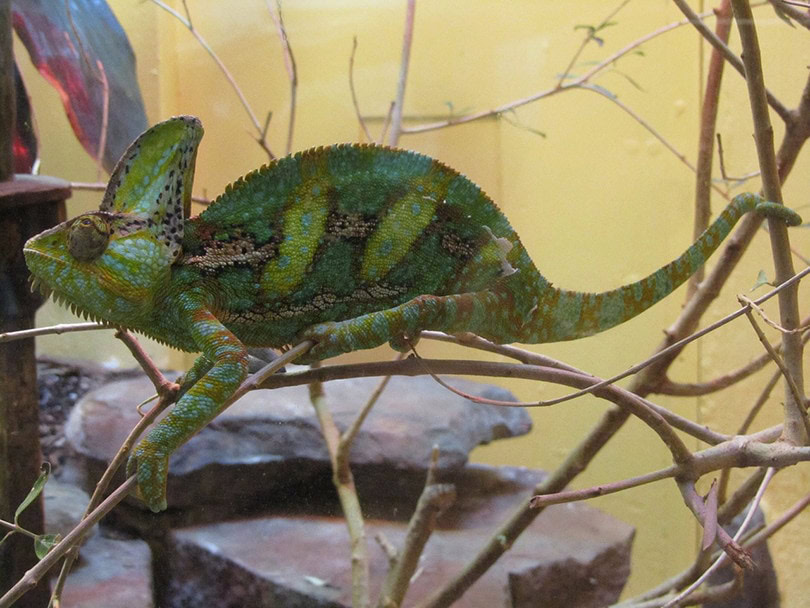
Veiled Chameleon Heating and Lighting
Veiled chameleons tend to bask every morning. These cold-blooded lizards have to utilize the sun and other natural heat sources to maintain a healthy body temperature. As a chameleon owner, you need to ensure that you have the proper heating and lighting to best replicate your pet’s needs.
Incandescent and fluorescent lights are needed in addition to thermometers to ensure proper temperature settings. The fluorescent light is needed as the main light source, and the incandescent light will serve the basking area. Make sure to keep the basking light at least 2 inches from the cage to prevent burning.
The ambient temperature in your veiled chameleon’s enclosure should be somewhere between 74 and 90 degrees Fahrenheit. Do not allow temperatures to drop any more than 10 degrees during the night.
Chameleons require UV rays to convert inactive vitamin D into active vitamin D for the body to properly absorb calcium. Lack of UVB lighting can result in devastating health effects, such as metabolic bone disease.
Veiled Chameleon Water and Humidity Requirements
You will need to mist the plants within the enclosure and provide a drip system for your veiled chameleon’s hydration. It is necessary to ensure that you only use fresh, clean water. Doing this daily not only provides needed hydration but also helps keep the proper humidity levels within the enclosure.
Ideal humidity levels are approximately 50 to 65 percent for veiled chameleons and this can be checked by purchasing a hygrometer.
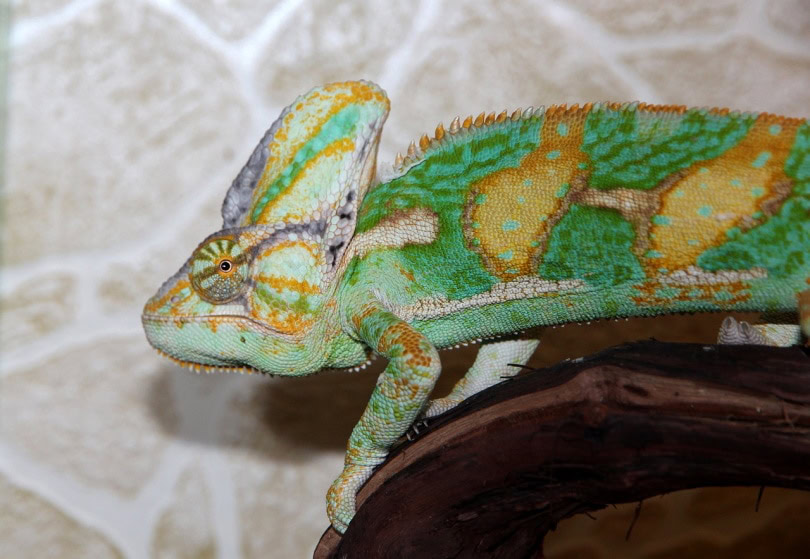

Summary
A veiled chameleon typically costs $79.99 for a single specimen from PetSmart. Not only are these animals available at this pet store, but there are also reputable reptile breeders who provide captive-born specimens as pets.
Veiled chameleons are interesting and have a striking coloration and overall appearance. While they may look amazing, they are not the pet for everyone. They have pretty specific care requirements and are not a pet that wants to be handled.
You need to ensure that your needs are compatible with the needs of these incredible little creatures and that you can provide the proper home for them to thrive.
Featured Image Credit: Pexels
